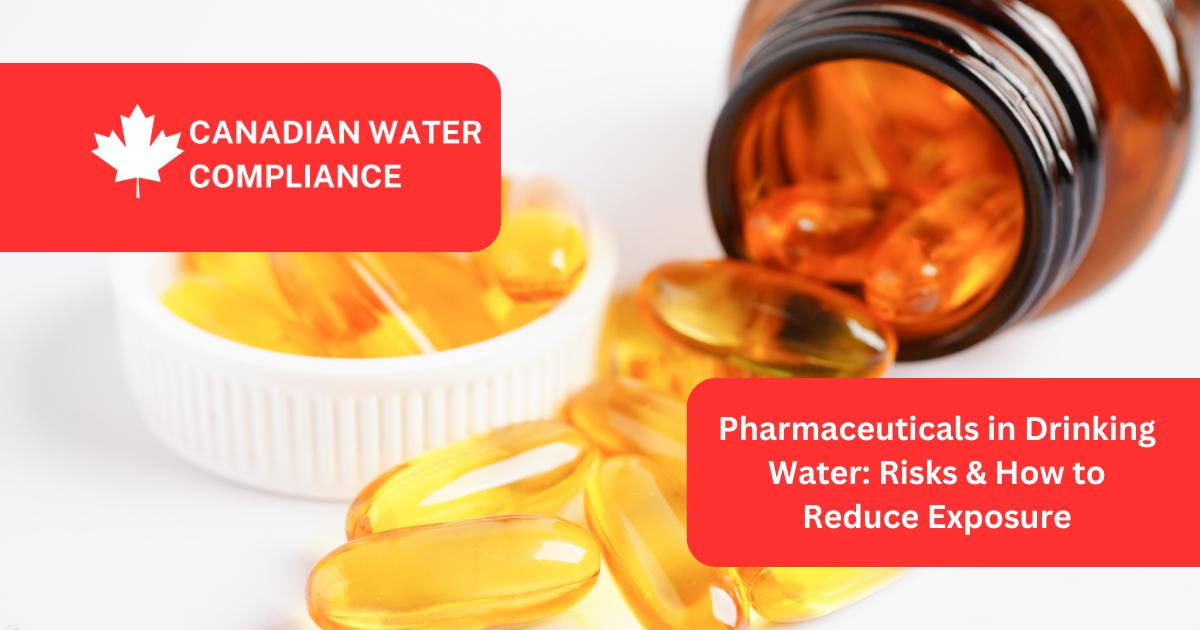
Written By: Canadian Water Compliance | On
The presence of pharmaceuticals in drinking water has become an increasing concern as studies detect traces of antibiotics, hormones, painkillers, and antidepressants in municipal water supplies worldwide. While these concentrations are often extremely low, ongoing research raises questions about the long-term health and environmental impacts of pharmaceutical contamination.
In this guide, we’ll cover:
✔ How pharmaceuticals end up in drinking water
✔ Potential risks to human health
✔ Environmental impacts on aquatic ecosystems
✔ How water treatment facilities manage pharmaceutical contamination
✔ What consumers can do to reduce the risk
Many medications are not fully metabolized by the body, meaning they pass through urine and feces into wastewater systems. Additionally, people often dispose of unused or expired medications by flushing them down toilets or rinsing them down sinks, introducing pharmaceutical compounds into the water supply.
The livestock industry uses antibiotics and growth hormones extensively. These substances enter local waterways through manure runoff, contaminating surface and groundwater sources.
Pharmaceutical factories and chemical manufacturers sometimes release trace amounts of drugs into wastewater during production, leading to contamination in rivers and lakes that supply drinking water.
Most municipal water treatment plants are not designed to remove pharmaceuticals, as they primarily target bacteria, heavy metals, and sediments. This means small traces of drugs can remain in tap water even after standard treatment.
Although research is still ongoing, scientists have expressed concerns about long-term exposure to low levels of pharmaceuticals in drinking water. Potential health effects include:
🚨 Hormonal Disruptions – Estrogenic compounds from birth control pills and hormone replacement therapy have been linked to endocrine system disruptions, which can affect fertility and development.
🚨 Antibiotic Resistance – The presence of antibiotics in water can contribute to antimicrobial resistance (AMR), making infections harder to treat.
🚨 Neurological & Behavioral Effects – Some studies suggest that trace amounts of antidepressants, antipsychotics, and painkillers in water could affect brain chemistry over time, although more research is needed.
Pharmaceutical contamination doesn’t just affect humans—it can have severe consequences for aquatic life:
🐟 Endocrine Disruptions in Fish – Studies have found that exposure to hormones in water supplies can cause feminization of male fish, leading to reproductive issues.
🐸 Developmental Abnormalities in Amphibians – Trace levels of pharmaceuticals have been linked to growth defects in amphibians, affecting population stability.
🦐 Bioaccumulation in the Food Chain – Some compounds can accumulate in aquatic organisms, potentially impacting larger predators (including humans who consume fish).
Most municipal water treatment systems are not specifically designed to filter out pharmaceuticals. However, some advanced technologies can help:
✅ Activated Carbon Filtration – Absorbs many organic contaminants, including pharmaceuticals.
✅ Reverse Osmosis (RO) Systems – Effective at removing pharmaceuticals, but costly for large-scale use.
✅ Advanced Oxidation Processes (AOPs) – Uses ozone, UV light, or hydrogen peroxide to break down contaminants.
While some cities have adopted these methods, many municipalities lack the infrastructure to fully eliminate pharmaceutical contaminants.
💊 Dispose of Medications Properly – Instead of flushing old medications, use designated drug take-back programs or pharmacy disposal services.
🌱 Limit Overuse of Medications – Avoid unnecessary prescriptions and use antibiotics responsibly to help combat resistance.
💧 Consider Home Water Filtration – Household reverse osmosis or activated carbon filters can reduce pharmaceutical traces in tap water.
🏛 Support Policy Changes – Advocate for improved wastewater treatment policies and regulations on pharmaceutical disposal.
While the levels of pharmaceuticals in drinking water are typically low, long-term exposure and environmental impacts remain a concern. As research continues, both individuals and policymakers must take steps to reduce contamination. By properly disposing of medications, supporting improved filtration systems, and staying informed, we can help protect both human health and the environment.
🔎 Concerned about your drinking water? Contact Canadian Water Compliance for professional testing and filtration solutions!